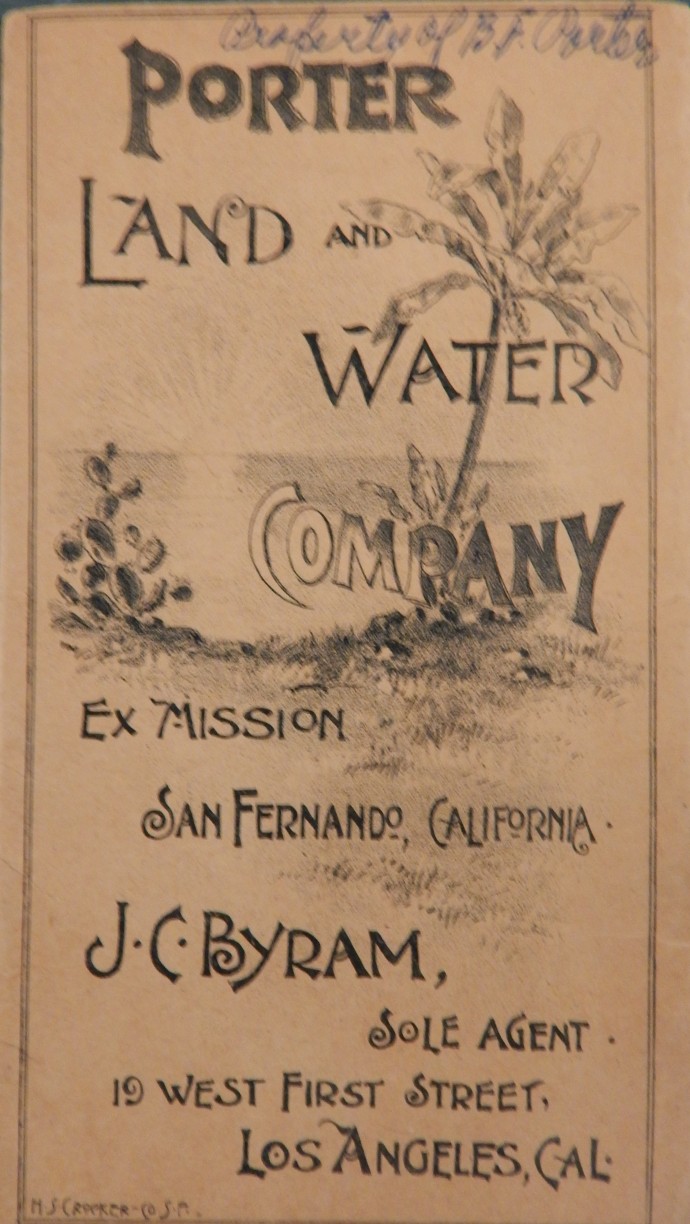
Cover of a circa 1889 promotional pamphlet for the Porter Land and Water Company, from the collection of the Lopez Adobe.
Another great recent find in the Lopez Adobe collection was an original circa 1889 pamphlet for the Porter Land and Water Company, which subdivided a 20,000-acre section of the former Rancho ex-Mission San Fernando that was formerly the ranch of George K. Porter.
In 1874, Robert Maclay created the townsite of San Fernando during the Los Angeles region’s first boom period, which began in the late 1860s and brought thousands of new residents to the area. Other towns that sprung up during this period included Pasadena, Pomona, and Artesia, but, by 1876, the boom went bust and most of these communities stagnated for a decade.
But, with the arrival of a direct transcontinental railroad, the Santa Fe line, from the east in 1885, a new boom arose and this one was far larger than its predecessor. As new arrivals poured in, more land was subdivided and placed on sale for steeply-rising prices. George K. Porter jumped at the opportunity and launched the Porter Land and Water Company, capitalized at over $500,000.
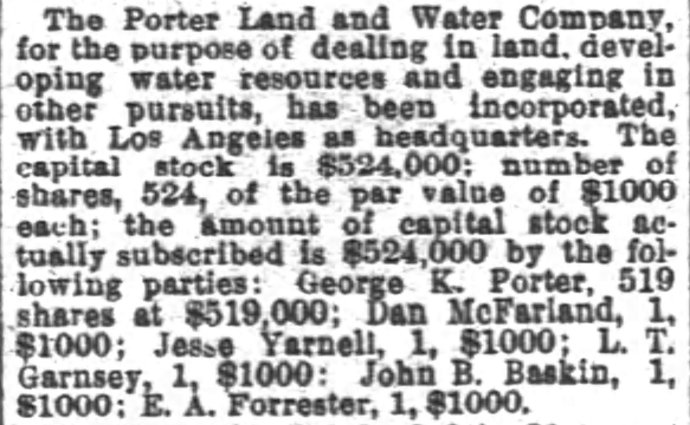
San Francisco Chronicle, 3 June 1887.
He took almost all of the stock, with a few partners investing $1,000 each for a single share. These included Jesse Yarnell, a newpaper publisher; Dan McFarland, who invested heavily in the Boom of the 1880s; Lehman T. Garnsey, a new arrival in the area and an investor in what became Burbank; Edward A. Forrester, a real estate developer and future county supervisor; and John B. Baskin, who became the sales agent for the new firm.
Baskin immediately began an aggressive marketing and promotional campaign for the subdivision of San Fernando-area land, doing so in a hyper-competitive environment in which almost every new project featured the finest soil, the balmiest climate, ample water and amenties galore.
One of the frequently-mentioned elements of the company’s holdings was the fact that the remains of Mission San Fernando were surrounded by the tract and the usual comparisons were made between the “days of old” represented by the crumbling walls of the mission and the progress represented in the Boom of the 1880s.
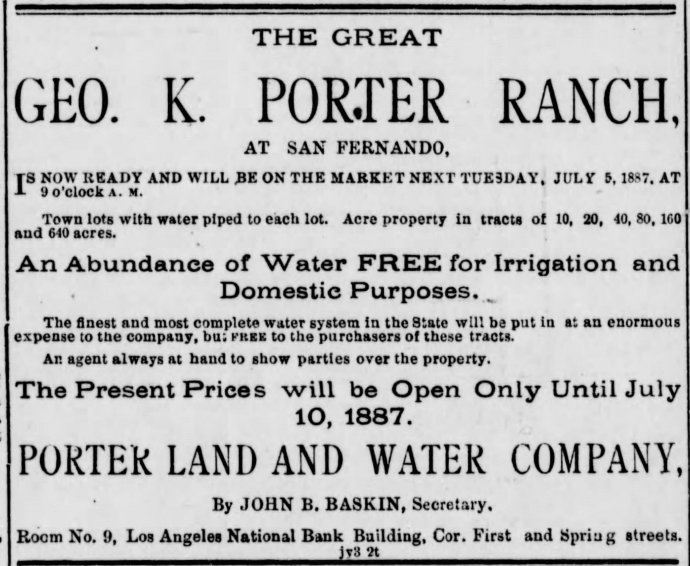
Los Angeles Herald, 3 July 1887.
The first advertisements were published in local newspapers on 3 July and sales commenced two days later, including town lots as well as parcels ranging from 10 to 640 acres. Baskin hired William Hammond Hall, California State Engineer and an expert on water, to develop a comprehensive irrigation plan for water derived from local creeks (such as Pacoima) and springs. Hall also offered his opinion that Porter Land and Water controlled “really first-rate valley lands for cultivation, with soils not to be surpassed for fertility” as well as “in a neighborhood whose climate is well-adapted to the best class of agricultural, horticultural and vineyard productions usual in this country.”
On 22 July, it was announced that the firm bought a lot in San Fernando from Martin Murnane for a hotel–this became the 70-room Porter Hotel, though it was originally the San Fernando Mission Hotel. Two days later, Baskin published a “card” in the Los Angeles Herald with a statement from long-time local residents attesting to the fact that “the oranges produced on said ranch are as fine as any we have seen in the State, and we further swear that scale bugs do not, and never have existed on any trees on the ranch.”
The signatories included Porter’s ranching partner, Henry C. Hubbard; Benigno Pico, who was married to Edward Forrester’s sister in a rare inter-ethnic marriage of the time; Southern Pacific station agent, W.H. Griswold; John T. Wilson; and Wilson’s father-in-law, Gerónimo López. Lopez’s 25 years of residency in the area (meaning his arrival was in 1861 or 1862) was by far the longest of the eight signatories, who swore their statement before San Fernando’s justice of the peace, T.S. Smith.
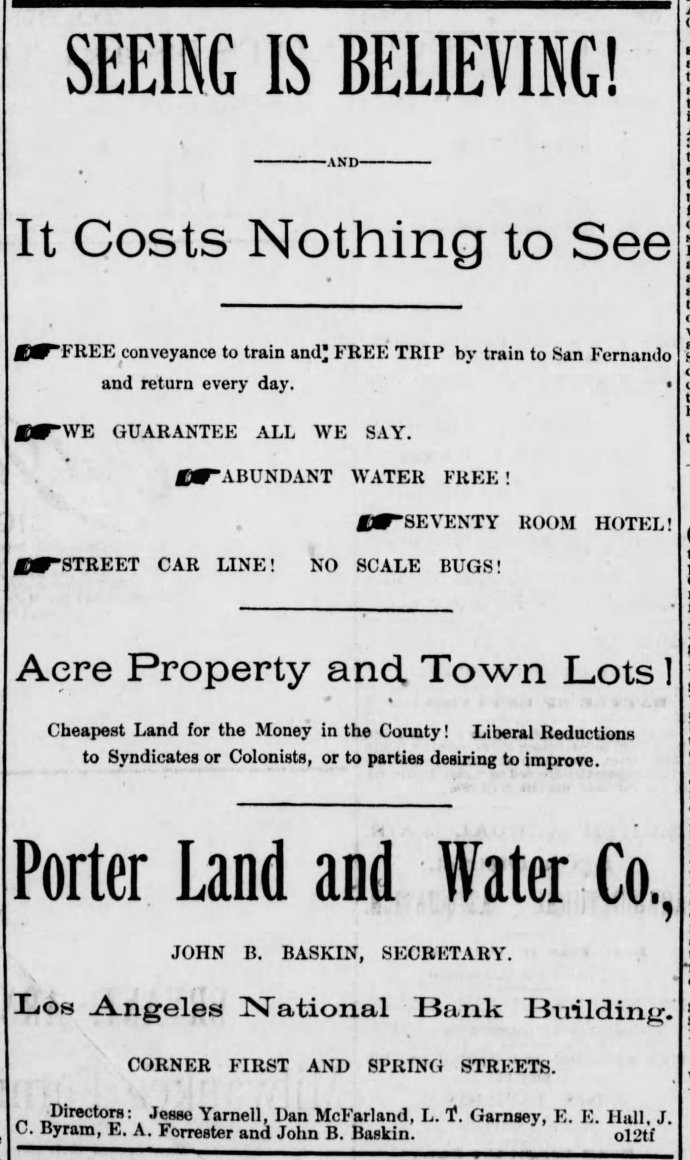
Los Angeles Herald, 12 October 1887
In late August, the biggest sale registered by Porter Land and Water was 1,500 acres in the center of the tract to Theodore Wisendanger, a native of Switzerland, who came to Los Angeles in 1884, just before the boom erupted, for some $250,000. Wisendanger, upon his arrival in the area, taught briefly at a little new and unknown Methodist college called U.S.C. and then dove headlong into real estate, developing some 3,000 acres and building hundreds of houses. He also was a pioneer in building apartments, amassing a portfolio of some forty buildings, though he died poor and almost forgotten in 1919.
The Porter Land and Water Company even tried to sell stock on the new Los Angeles Stock Exchange, offering initially for the $1,000 per share price assigned in the company’s formation. As the boom moved into 1888, the offered value rose to nearly $1,200, though it is unknown how many investors joined in. The company did add two directors, enlarging its number to seven, that year.
As 1888 dawned, the company was offering its land for $50 an acre, with a 40-acre lot being the most commonly marketed and sold plot. An upfront cash payment of 1/3 was expected, with the remainder due either in one or two years at 6% interest. In February, it was announced that a little under 500 acres of the property was being planted to oranges to demonstrate the fertility of the soil, the absence of pests, and the abundance of water that would make cirtus raising a profitable endeavor on the firm’s lands.
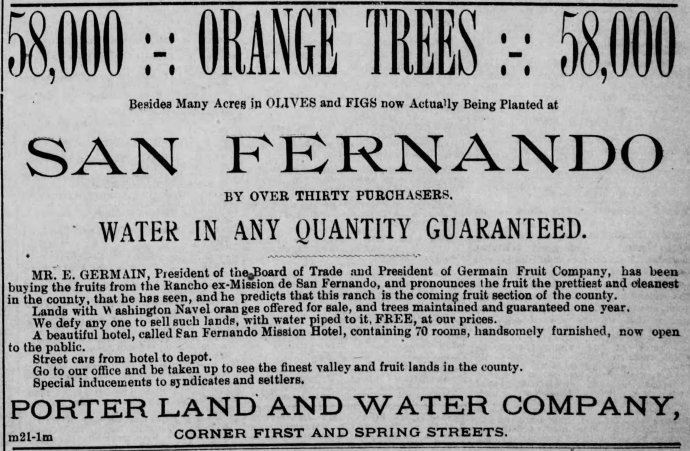
Los Angeles Herald, 23 March 1888.
Besides 58,000 orange trees, as claimed in a March advertisement, figs and olives were represented as flourishing on the Porter property. In later years, the olive groves and production facilities at Sylmar would become widely-known. In the ad, Baskin enlisted Eduard Germain, one of Los Angeles’ biggest fruit dealers, quoted as saying that the fruits of the company’s tract were “the prettiest and cleanest in the county” and that “this ranch is the coming fruit section of the county.”
On 6 April 1888, Porter Land and Water offered a “grand excursion” from Los Angeles to the tract with the subsidized train ride, tour and lunch only costing 75 cents. The recently planted orange grove was touted as the largest in the world. The Herald‘s coverage included the wording of a statement that many of the excursionists signed about the “excellent manner in which we were treated” as well as “the fine appearance of the country and the extensive improvements being made” which “prove that the land of the Company has not been praised near what it deserves.”
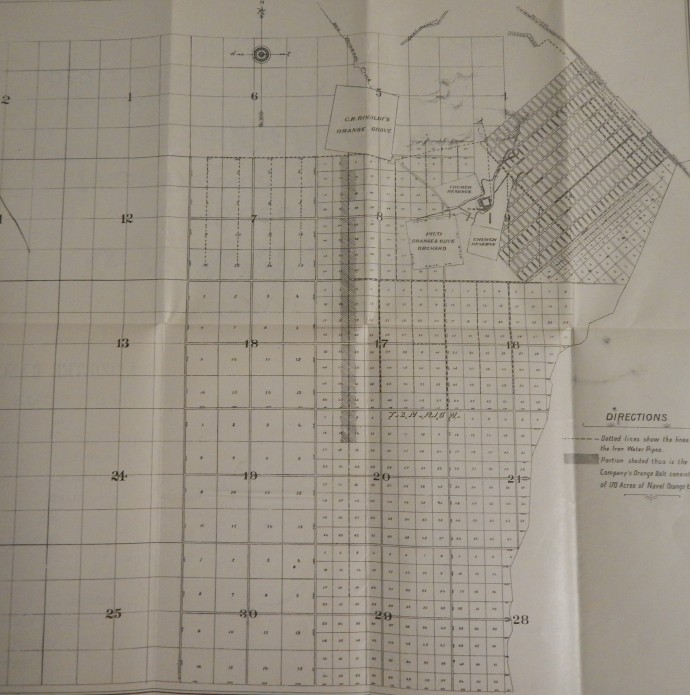
The fold-out map of Porter Land and Water Company holdings from the 1889 pamphlet.
As the year wound towards a close, the boom began to fade and problems ensued within Porter Land and Water. On the latter point, a bookkeeper, Thomas Gaskins, forged some company checks payable to himself and skipped town, leaving his teenaged wife and infant son behind. He was captured in San Francisco and brought back to Los Angeles for criminal proceedings, though the outcome was not located.
Early in 1889, John B. Baskin was taken to court by the company. Baskin, it was noted was paid $100 per month and given a 6% commission on all sales as part of his work as agent, but Porter Land and Water charged that Baskin engineered “pretended” sales and collected his commission on others that were never fully realized or perfected. The company alleged that Baskin, who received some $15,000 in salary and fees in ten months (a very large sum), also had promissory notes against the firm for other work, charged the firm $2,000 to a personal account, and had property put in the name of his wife and then transferred to him. The total of alleged false fees and other income was some $6,000. The firm demanded that Baskin only receive the total of his salary and commission on actual, realized and perfected sales. While the matter did proceed in court, no outcome was located, though it may be that there was an out-of-court settlement.
By 1889, the firm had a new agent, J.C. Byram, whose name appears on the pamphlet pictured here. Byram, however, could do little to turn around sales, when the boom was bust, and the national and local economies were heading towards a depression, which broke out in 1893. Additionally, much of the 1890s found the region in a severe drought.
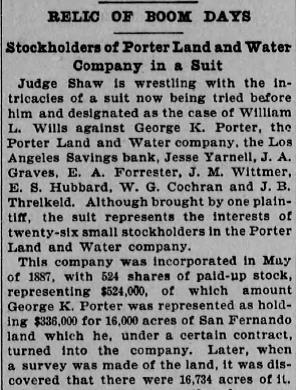
Los Angeles Herald, 23 June 1898.
An 1898 Herald article on another company lawsuit, this one against Porter, his company, and officers and directors in Porter Land and Water, was headlined “Relic of Boom Days.” It was just a decade removed, but the glory days of the boom were already worthy of “relics” by the late Nineties.
The suit was brought by 26 “small stockholders” in the firm and they alleged that as “the years rolled by and the land did not sell,” Porter and associated borrowed $100,000 from a bank on the company’s credit, with Porter being paid some $45,650 out of the borrowed money for 734 acres that he transferred to the company. The plaintiffs argued that the 734 acres had to be sold before Porter was paid. The 26 stockholders won their case at the local Superior Court, but the judgment was reversed on appeal by the state Supreme Court. The affair shows the low state of the company as the 1890s ended.
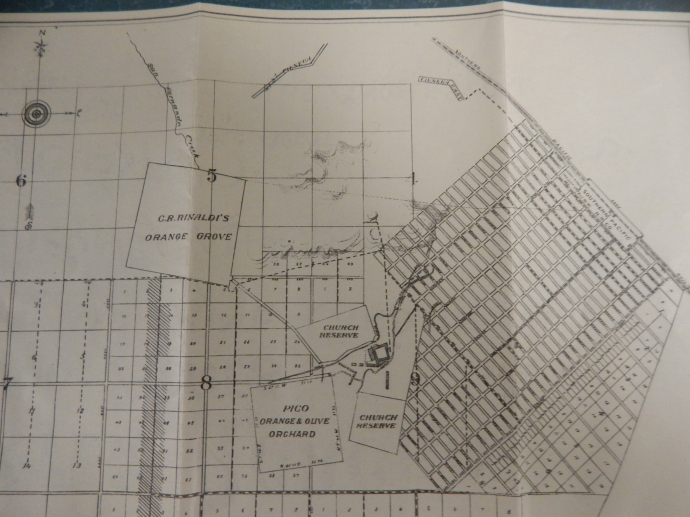
Detail from the circa 1889 map from the Porter Land and Water Company pamphlet showing the townsite of San Fernando at right, the Mission San Fernando at the center, the location of the Andres Pico Adobe at lower center, and the Rinaldi orange grove towards the upper left.
Five years later, in 1903, Porter sold his firm and transferred remaining acreage in the San Fernando area to a new company, the San Fernando Mission Land Company, of which he was a minority owner, holding 10% of the stock. Three years after that, in 1906, he died, without much of the property he owned and developed being sold, though it was not long afterward that a new rush of settlers came to the San Fernando Valley, which was the terminus, from 1913, of the Los Angeles Aqueduct.

